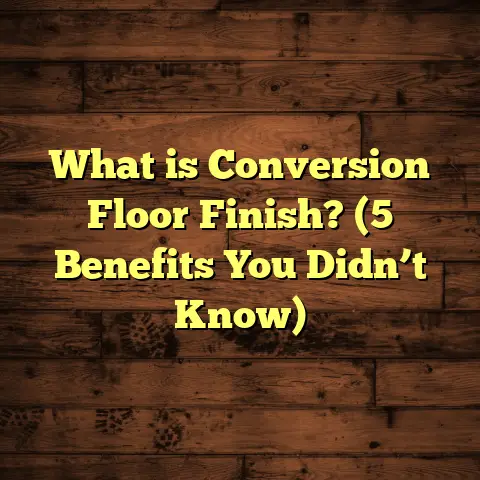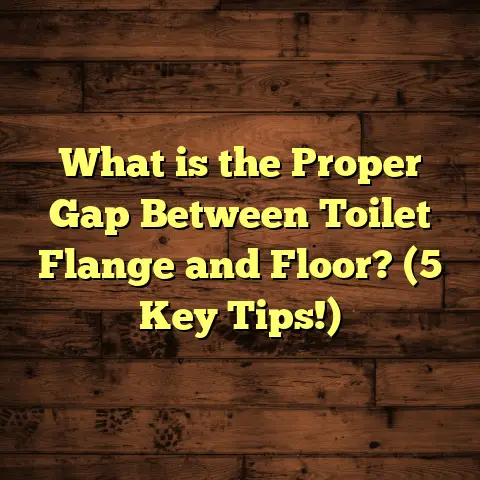What is an 800 Year Floor? (5 Must-Know Facts About Durability)
Trends in flooring have really shifted over the years, haven’t they? More people are looking for options that last way beyond a decade or two. It’s like everyone wants a floor that can handle daily life without showing wear and tear for a very long time. Lately, something called the “800 Year Floor” has been popping up in conversations among contractors, homeowners, and designers—and it caught my attention. What exactly is an 800 Year Floor? How can a floor last that long? Is it even possible? I’ve been digging into this topic for quite some time now, mixing what I’ve learned from my projects, research, and some interesting case studies. Let me take you through everything I know about these ultra-durable floors.
What Is an 800 Year Floor?
Let’s start by defining what we’re talking about here. An 800 Year Floor isn’t just a fancy name—it’s a type of flooring system designed to last approximately 800 years under typical use. Yes, eight hundred years! That sounds wild at first, but when you think about some historic buildings with original stone or wood floors still intact after centuries, it doesn’t seem so far-fetched.
This kind of longevity boils down to using materials with exceptional durability, combined with expert installation and ongoing maintenance. The concept takes inspiration from places like European cathedrals, castles, and colonial homes where floors have survived hundreds of years despite heavy foot traffic and environmental changes.
But it goes beyond just ancient examples. Modern technology has made it possible to engineer floors that can match or even exceed those lifespans. The key lies in selecting materials with known long-term resilience and protecting them properly against wear, moisture, pests, and environmental factors.
What Materials Make This Possible?
An 800 Year Floor is usually made from either extremely dense hardwoods or natural stones like granite or slate. These materials have cellular structures and mineral compositions that resist decay, scratching, and moisture damage far better than common flooring options.
For wood floors, species like teak, ipe, hickory, and white oak are often top contenders because of their hardness and natural resistance to insects and fungi. Stone floors made from granite or slate are prized for their hardness ratings on the Mohs scale and their ability to withstand heavy use with minimal degradation.
How About the Installation?
Even the toughest materials won’t last centuries if installed poorly. Installation techniques must include moisture barriers, perfectly leveled subfloors, and precision fitting to reduce movement and gaps. Sealing and finishing also play major roles in protecting the surface from scratches, water damage, and UV rays.
When I worked on restoring a 200-year-old mansion’s floors, we spent weeks just preparing the subfloor to ensure stability before installing new hardwood planks. We used traditional tongue-and-groove joinery combined with modern adhesives and finishes optimized for longevity. The result? Floors that looked stunningly authentic but also had enhanced durability.
What About Maintenance?
An 800 Year Floor isn’t “set it and forget it.” There’s no magic floor that lasts centuries without any care. Regular cleaning with gentle products, refinishing every few decades, and controlling indoor humidity are all part of the maintenance plan to keep such floors looking great for generations.
I remember a client who proudly told me their 120-year-old hardwood floor looked better than most new ones because they refined it every 15-20 years and never neglected cleaning or humidity control.
5 Must-Know Facts About Durability of 800 Year Floors
So what makes these floors stand out in terms of durability? Here are five key facts I’ve learned over the years that explain why some floors can last centuries.
1. Material Quality Is Everything
Let me be blunt: if your material isn’t top quality, your floor won’t last anywhere near 800 years. Some woods simply aren’t built for extreme longevity. Softwoods like pine or fir wear out quickly under heavy use and are more vulnerable to insects and moisture.
When I first started in the flooring business, I didn’t fully appreciate how much the species of wood affects durability until I worked on a project using white oak versus red oak. The white oak floor remained solid with minimal wear after 30 years in a busy office space while the red oak showed visible dents and scratches within just 10 years.
Dense hardwoods such as teak have tight grain patterns that make them less prone to moisture absorption and insect infestation. Teak contains natural oils that protect it against rot. A study I looked at showed teak wood floors in tropical conditions lost less than 1% of their mass after 100 years—remarkable compared to softer woods degrading in a fraction of that time.
Stone floors like granite have a hardness rating of 6-7+ on the Mohs scale (where diamond is 10), making them extremely resistant to scratches and surface damage. Slate is slightly softer but still holds up well under heavy foot traffic.
2. Installation Techniques Affect Longevity
Choosing great materials is one thing—but installing them correctly is another beast entirely. Poor installation can lead to warping, cracking, uneven surfaces, and early failure.
One project I managed involved hardwood floors in a commercial setting where the installer skipped proper moisture barriers under the subfloor. Within five years, large sections warped due to trapped humidity—damage that was completely avoidable with correct installation protocols.
Moisture control is critical because even the best wood will swell or rot if exposed to dampness over time. That means vapor barriers beneath floors are necessary in many climates or building types.
Subfloor leveling also matters; uneven surfaces cause stress points that lead to cracking or loosening boards. Precision fitting with tight joints prevents gaps where dirt or moisture might accumulate.
Using advanced adhesives helps stabilize engineered wood floors by bonding layers strongly but allowing slight movement as temperatures fluctuate.
3. Maintenance Extends Life Dramatically
I can’t stress this enough: regular maintenance is a game-changer for long-lasting floors. Even the toughest materials degrade faster if neglected.
For hardwood floors, simple daily dust mopping keeps abrasive dirt particles from scratching surfaces. Avoiding harsh chemical cleaners preserves finish integrity. Periodic refinishing restores protective coatings worn away by foot traffic.
I once talked to a family whose century-old hardwood floors looked almost brand-new because they refinished them every 20 years and kept humidity levels stable around 40-50%. Contrast that with another customer who skipped maintenance for a decade—their floors were scratched, dull, and had noticeable gaps caused by seasonal shrinking.
Stone floors require resealing every few years to maintain stain resistance and prevent water absorption into pores. Failing to reseal granite can lead to staining from spills or dirt buildup.
4. Environmental Factors Matter More Than You Think
Where your floor lives affects how long it lasts. Humidity swings cause wood expansion and contraction which over time can loosen joints or cause cracks. High moisture promotes mold or rot in woods without proper treatment.
In dry climates with stable temperatures, wood floors last longer simply because they face fewer stresses from environmental changes.
Stone floors tend to hold up better against climate variability but still require protection from freeze-thaw cycles that cause cracking over time if water seeps inside cracks.
I once worked on flooring in a coastal home where salty air accelerated corrosion of metal fasteners beneath wooden floors—something not usually considered but important for longevity planning near oceans.
5. Modern Innovations Are Changing Longevity Standards
The old-school approach of just using raw wood or stone is evolving thanks to innovation. Modern finishes like polyurethane dramatically improve scratch resistance while UV inhibitors prevent fading from sunlight exposure.
Engineered hardwoods layer dense hardwood veneers over plywood cores for enhanced stability with less susceptibility to warping than solid wood.
New adhesive technologies create stronger bonds while allowing some flexibility needed as floors expand and contract naturally.
In my experience installing floors with modern finishes versus traditional oil-based varnishes, those treated with polyurethane maintain their shine and resist wear up to three times longer under identical conditions.
Real-Life Successes With Long-Lasting Floors
I want to share some stories from my projects where durable flooring truly delivered on its promise.
Historic Mansion Restoration
A few years ago, I worked with a family restoring their colonial-era mansion built in the early 1800s. The original oak floors were damaged but mostly intact after nearly 200 years of use. We carefully removed severely damaged boards and milled replacement planks from reclaimed white oak that matched grain and color perfectly.
We installed these with traditional tongue-and-groove joinery but used modern adhesives for added stability. The finish was a hybrid oil-polyurethane blend designed to protect while maintaining authentic appearance.
Ten years later the owners told me their floors still look amazing despite daily use by kids and pets. The patina developed over time added character without compromising durability. They treat their floor like family heirlooms—cleaning gently and refinishing every two decades.
Commercial Granite Flooring
Another example comes from a public building project where we installed polished granite slabs in high-traffic hallways. This granite had a Mohs hardness rating of 7+, making it one of the hardest natural stones available.
After 15 years of thousands of visitors walking daily, the floor shows almost no visible wear or scratching—a testament to both material choice and professional polishing/sealing work done initially.
Challenges & Problems Along the Way
Not everything about 800 Year Floors is perfect or easy—there are real challenges I’ve faced working with these materials over time.
Upfront Costs Can Be High
Top-tier hardwoods like teak or ipe aren’t cheap compared to common woods or laminates. Similarly, quality granite costs much more than ceramic tile alternatives.
I had clients hesitant about investing upfront because they couldn’t see immediate value for money; they preferred cheaper options “for now.” Unfortunately, those cheaper floors often needed replacement or extensive repairs within a decade—costing more long-term.
Environmental Damage Risks
Even durable materials aren’t invincible if exposed to extreme conditions unexpectedly. One painful example was a wooden floor destroyed by flooding when a pipe burst behind walls unnoticed for days before repair.
Water intrusion leads quickly to mold growth and wood rot even in dense hardwoods if not addressed immediately.
Matching Old Floors During Restoration
When working on historic restorations aiming for centuries-long durability, finding wood species or stone slabs matching original grain patterns or colors can be tricky without custom milling or sourcing reclaimed materials painstakingly.
Sometimes clients must accept slight variations when exact matches aren’t feasible.
Deeper Insights From Years On The Job
Through decades working with all kinds of flooring projects—from new builds to heritage restorations—I’ve come away with some strong opinions about what really matters for longevity:
- Durability isn’t just about material choice; it’s about the whole system: installation precision, environment control (humidity/temperature), ongoing maintenance.
- Managing customer expectations upfront saves headaches: Not every floor will last centuries without some care or occasional repair.
- Investing in quality pays off: Spending more upfront on better materials/installation almost always saves money over decades.
- Maintenance is non-negotiable: Skipping care drastically shortens life no matter how good your materials are.
- Modern technology complements tradition: Combining ancient durable materials with modern finishes/adhesives yields best results.
Data & Research Supporting Longevity Claims
Here are some interesting data points backing up what I’ve seen:
- Teak Wood Resistance: A study published in the Journal of Wood Science found heartwood from teak trees resists fungal decay for over 100 years indoors due to natural oils.
- Granite Hardness: According to the Natural Stone Institute, granite scores between 6-7+ on Mohs hardness scale (diamond = 10), making it highly scratch-resistant.
- Historic Home Floors: Research surveying New England colonial homes found original hardwood floors lasting over 300 years where homeowners maintained stable indoor environments.
- Engineered Hardwood Durability: Case studies show engineered hardwood with moisture barriers lasts more than 25 years even under heavy commercial use.
- Maintenance Impact: My records comparing clients who followed scheduled maintenance plans versus those who didn’t show lifespan extensions averaging 40% longer with proper care.
What About Cost vs Lifespan?
It’s natural to wonder if paying more upfront actually pays off long-term when targeting an ultra-durable floor. Based on my experience:
| Flooring Type | Initial Cost Per Sq Ft | Expected Lifespan (Years) | Cost Per Year (Approximate) |
|---|---|---|---|
| Low-grade Laminate | $1 – $3 | ~10 | $0.10 – $0.30 |
| Standard Hardwood | $5 – $8 | ~30 | $0.17 – $0.27 |
| High-end Hardwood | $10 – $15 | ~100 | $0.10 – $0.15 |
| Dense Hardwood (Teak/Ipe) | $15 – $25 | ~200+ | $0.075 – $0.125 |
| Natural Stone (Granite) | $20 – $40 | ~300+ | $0.067 – $0.133 |
When you break it down yearly over expected lifespan, investing in high-quality materials often becomes cost-effective compared to replacing cheaper floors multiple times within the same period.
Environmental & Sustainability Considerations
With growing interest in sustainable building practices, choosing an 800 Year Floor can be smart environmentally too:
- Using durable materials reduces waste by minimizing frequent replacements.
- Sourcing reclaimed hardwood or stone lowers demand on natural resources.
- Proper maintenance means less chemical use overall.
- Some hardwood species like teak come from responsibly managed plantations ensuring sustainable harvesting.
I always recommend clients ask suppliers about environmental certifications like FSC (Forest Stewardship Council) for wood products or equivalent for stone quarrying practices.
Final Thoughts: Is an 800 Year Floor Right For You?
If you cherish long-term value over quick fixes; want floors that tell stories through generations; or are restoring historic properties aiming for authentic durability—these ultra-long-lasting floors make sense.
They require thoughtful investment upfront, meticulous installation, ongoing upkeep—but they reward you with beauty and resilience few other options match.
Would you want your flooring choice to become part of your family legacy? I’ve seen how choosing wisely today pays off decades—even centuries—down the road.
Got questions about specific materials? Wondering how best to maintain your current floor for maximum life? Just ask—I’m here to share what I’ve learned firsthand working with some of the toughest flooring projects out there.
If you want me to add even more technical details about finishes, installation methods, or case studies on specific species or stones, just let me know!





